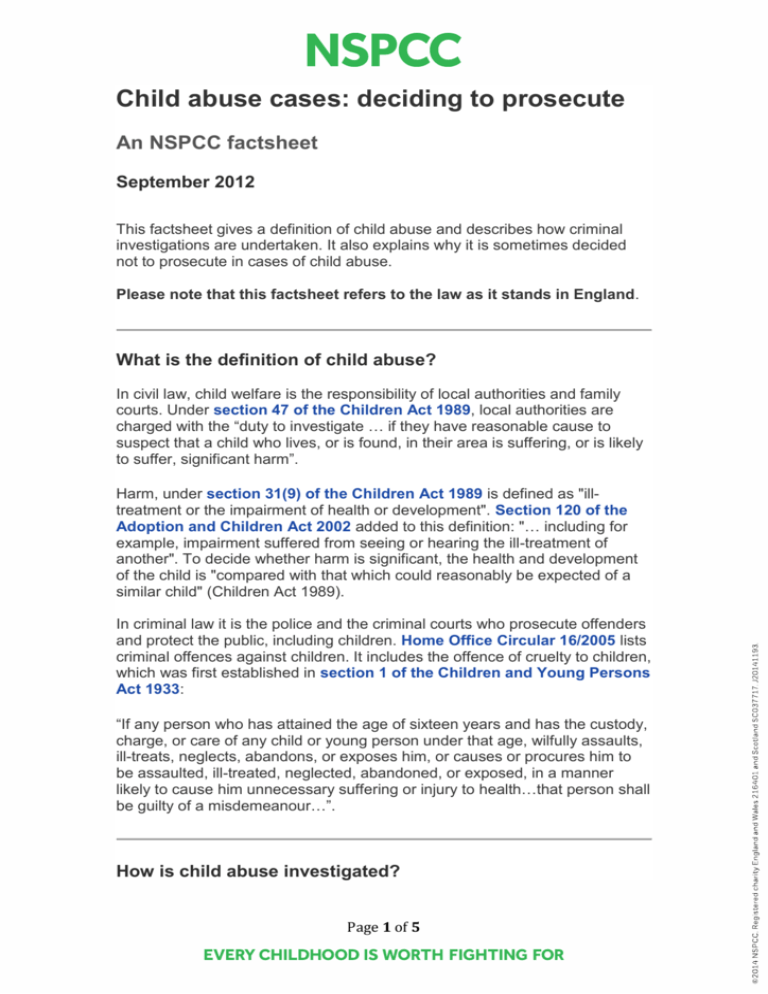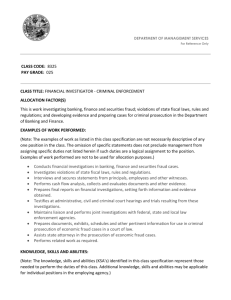
Child abuse cases: deciding to prosecute
An NSPCC factsheet
September 2012
This factsheet gives a definition of child abuse and describes how criminal
investigations are undertaken. It also explains why it is sometimes decided
not to prosecute in cases of child abuse.
Please note that this factsheet refers to the law as it stands in England.
What is the definition of child abuse?
In civil law, child welfare is the responsibility of local authorities and family
courts. Under section 47 of the Children Act 1989, local authorities are
charged with the “duty to investigate … if they have reasonable cause to
suspect that a child who lives, or is found, in their area is suffering, or is likely
to suffer, significant harm”.
Harm, under section 31(9) of the Children Act 1989 is defined as "illtreatment or the impairment of health or development". Section 120 of the
Adoption and Children Act 2002 added to this definition: "… including for
example, impairment suffered from seeing or hearing the ill-treatment of
another". To decide whether harm is significant, the health and development
of the child is "compared with that which could reasonably be expected of a
similar child" (Children Act 1989).
In criminal law it is the police and the criminal courts who prosecute offenders
and protect the public, including children. Home Office Circular 16/2005 lists
criminal offences against children. It includes the offence of cruelty to children,
which was first established in section 1 of the Children and Young Persons
Act 1933:
“If any person who has attained the age of sixteen years and has the custody,
charge, or care of any child or young person under that age, wilfully assaults,
ill-treats, neglects, abandons, or exposes him, or causes or procures him to
be assaulted, ill-treated, neglected, abandoned, or exposed, in a manner
likely to cause him unnecessary suffering or injury to health…that person shall
be guilty of a misdemeanour…”.
How is child abuse investigated?
Page 1 of 5
When a child is abused, the primary concern will usually be to ensure that the
child is protected from the risk of further abuse, and the child’s welfare will be
a priority in any child protection investigations and proceedings. "Wherever
possible, protection will be achieved by working in partnership with the child’s
carers, without the need to resort to formal state intervention. However,
particularly in cases where the child has suffered physical harm or has been
sexually abused, a criminal investigation will also be undertaken" (Cobley,
2005).
An investigation by the local authority’s child protection team may lead to a
child being placed on the child protection register and/or being removed from
home if they are considered to still be at risk. Assessments will be carried out
on the family in order to establish the level of risk to the child. The child
protection team has a duty to discuss the case with police if they believe the
abuse constitutes or may constitute a criminal offence (section 5.19 of HM
Government, 2010).
How are criminal investigations of child abuse undertaken?
All police forces have child abuse investigation units (CAIU’s), which normally
take primary responsibility for investigating child abuse cases. The police will
make the decision whether to proceed with a criminal investigation and, if
appropriate, the abuse will be recorded as a criminal offence. There will be
less serious cases where, after discussion, it is agreed that the best interests
of the child are served by a children’s social care-led intervention rather than
a full police investigation (HM Government, 2010).
The child protection and criminal investigations will usually be undertaken
simultaneously; the government has produced guidance to facilitate the
'working together' of agencies involved in child abuse investigations (HM
Government, 2010). Tensions may arise between the two investigations, often
as a result of the unwillingness of carers to cooperate with the investigations
and, in particular, the unwillingness of the abuser to admit responsibility for
fear of criminal prosecution (Cobley, 2005).
How many criminal prosecutions in cases of child abuse are
there and how are decisions made?
Only a proportion of child abuse cases initially investigated by local authorities
will lead to a criminal investigation and/or prosecution.
In 2010, 2,172 people in England and Wales were found guilty or cautioned
for the specific offence of 'cruelty to or neglect of children'. There are of
course other offences against children which lead to prosecutions, for
Page 2 of 5
example in the same year 309 people in England and Wales were cautioned
or found guilty of sexual activity with a child under 13, and 1,184 of sexual
activity with a child under 16 (see Tables A4.4 and A4.5 in Ministry of Justice,
2011a).
The Crown Prosecution Service decides whether or not a prosecution is in the
public interest. The Code for Crown Prosecutors (Crown Prosecution Service,
2010) is a public document that sets out the basic principles to be followed
when making a decision. Crown Prosecutors must be satisfied that there is
enough evidence to provide a 'realistic prospect of conviction' against each
defendant on each charge. They must also decide whether the evidence can
be used and whether it is reliable. If the evidential stage of the decisionmaking process is passed then the case moves to the public interest stage.
Public interest factors that can affect the decision to prosecute usually depend
on the seriousness of the offence or the circumstances of the suspect.
Why might it be decided not to prosecute in some cases of
child abuse?
The standard of proof in criminal proceedings is much higher than for civil
proceedings. The standard in criminal proceedings is 'beyond reasonable
doubt', whereas for civil proceedings it is the 'balance of probabilities'.
Previously in cases where each parent blamed the other for a child's injuries,
there was often not enough evidence to convict either.
This legal loophole (whereby defendants in murder and manslaughter cases
could escape conviction by claiming each other had killed the child) was
closed by the Domestic Violence, Crime and Victims Act 2004 which
provided for a new offence of causing or allowing the death of a child or
vulnerable adult.
The Domestic Violence, Crime and Victims (Amendment) Act 2012
extended the legislation to situations where children and vulnerable adults
have been seriously harmed.
Even where the perpetrator is known, there are many reasons for not
proceeding with a criminal prosecution:
moral culpability - for example where harm is deemed to be as a result of
poor parenting rather than criminal intent, it may be more appropriate to
look at the support needs of the family in order to improve parenting
dangerousness - the perpetrator is considered unlikely to re-offend
strength of evidence - evidence may fail to meet the standards required
for a realistic prospect of conviction
Page 3 of 5
concern for the welfare of the child (Gwynn et al, 1999).
It may not always be considered to be in the interests of the child to carry out
a criminal prosecution, since the experience of testifying at trial can be
traumatic. However, much has been done to improve the process for child
witnesses, including the availability of pre-trial therapy, use of intermediaries,
video suites for Achieving best evidence (ABE) interviews and the provision of
support services for young witnesses (Ministry of Justice, 2011b). The use of
video recorded evidence and live link TV are the preferred methods of hearing
children’s evidence in criminal proceedings, particularly in cases involving
allegations of sexual abuse.
Even where a child is the only main witness, a court can convict. Recent
cases have confirmed that properly directed juries can reach a safe
conclusion on the basis of the evidence of a single witness, whatever his or
her age and whatever his or her disability.
References
Cobley, Cathy (2004) 'Working together?': admissions of abuse in child protection
proceedings and criminal prosecutions. Child and Family Law Quarterly, 16(2): 175-187.
Crown Prosecution Service (2010) The code for Crown Prosecutors (PDF). London: CPS
Communication Division.
Davis, Gwynn, Laura Hoyano, Caroline Keenan, Lee Maitland and Rod Morgan (1999) The
admissibility and sufficiency of evidence in child abuse prosecutions (PDF). London:
Research, Development and Statistics Directorate.
Great Britain, laws and statutes (1933) Children and Young Persons Act 1933 (chapter
12). London, Her Majesty's Stationery Office (HMSO).
Great Britain, laws and statutes (1989) Children Act 1989 (chapter 41). London: Her
Majesty's Stationery Office (HMSO).
Great Britain, laws and statutes (2004) Domestic Violence, Crime and Victims Act 2004:
chapter 28. London: The Stationery Office (TSO).
Great Britain, laws and statutes (2012) Domestic Violence, Crime and Victims
(Amendment) Act 2012. London: The Stationery Office (TSO).
Her Majesty's Government (2010) Working together to safeguard children: a guide to
inter-agency working to safeguard and promote the welfare of children (PDF).
Nottingham: Department for Children, Schools and Families (DCSF).
Home Office (2005) Guidance on offences against children. Home Office
Circular,16/2005. [London]: Home Office.
The list of criminal offences in Home Office Circular 16/2005 includes law up to, and
including, the Domestic Violence, Crime and Victims Act 2004 and the Asylum and
Immigration (Treatment of Claimants, etc) Act 2004.
Ministry of Justice (2011a) Tables A4.4 and A4.5. In: Conviction tables: Criminal Justice
Statistics Quarterly Update to December 2010: Ministry of Justice Statistics bulletin
Page 4 of 5
(Excel). London: Ministry of Justice.
Ministry of Justice (2011b) Achieving best evidence in criminal proceedings: guidance
on interviewing victims and witnesses, and using special measures (PDF). [London]:
Ministry of Justice.
Contact the NSPCC Information Service with any questions about child
protection or related topics:
Tel: 0808 800 5000 | Email: help@nspcc.org.uk | Twitter: @NSPCCpro
Copyright © 2014 NSPCC Information Service - All rights reserved.
Page 5 of 5








